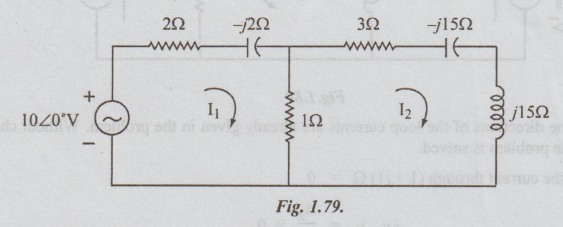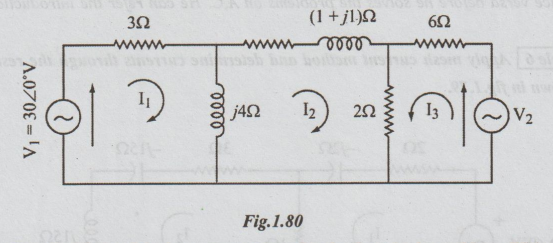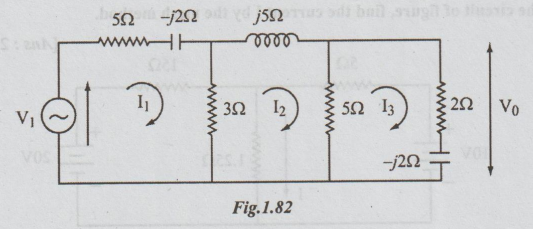Electric Circuit Analysis: Unit I: b. Basic circuits analysis
Solving AC circuits by loop current methods
Electric Circuit Analysis: Unit I: Basic circuits analysis : Solving AC circuits by loop current methods
Solving AC circuits
by loop current methods
[Very Important Note: The student should be thorough with the conversion of rectangular to polar and vice versa before he solves the problems on A.C. He can refer the introduction pages for help]
Example 6 Apply mesh current method and determine currents through the resistors of the network shown in fig.1.79.

Solution: By inspection,

[Hint: The student is advised to solve the problem by simplification of series parallel combination of impedances.]
Example 7 In the network shown in figure find V2 such that the current in the (1+j1) Ω branch is zero.

Solution: The directions of the loop currents are already given in the problem. Without changing the directions, the problem is solved.
Given that, the current through (1+j1) Ω = 0
i.e., I2 = ∆2/ ∆ =0
Hence, ∆2 = 0
= 96 < 37° volts In the matrix form, we get the loop
equation as below

Example 8 In the network shown in figure determine V2 such that the current in the 2+ j3 impedance is zero.

Solution: The directions of the loop currents here are not given. Hence, let us assume that they are all clockwise. Since the current through (2 + j3) is given to be zero, I2 = 0 => ∆2/ ∆=0 Hence the condition
Δ2=0, So, by inspection

Example 9 In the network shown in the figure the source V1 results in a voltage V0 across the (2-j2)Ω impedance. Find the source V1 which corresponds to V0=5<0° volts.

Solution: Let the loop currents be I1, 12 and I3.

Electric Circuit Analysis: Unit I: b. Basic circuits analysis : Tag: : - Solving AC circuits by loop current methods
Related Topics
Related Subjects
Electric Circuit Analysis
EE3251 2nd Semester 2021 Regulation | 2nd Semester EEE Dept 2021 Regulation
